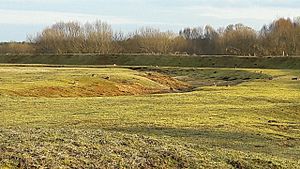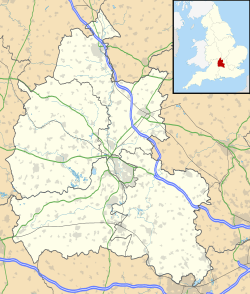Devil's Quoits facts for kids

The Devils Quoits ditch and stones
|
|
| Location | Stanton Harcourt |
|---|---|
| Coordinates | 51°44′24″N 1°24′21″W / 51.7400°N 1.4059°W |
| Type | Henge and Stone circle |
| History | |
| Periods | Neolithic / Bronze Age |
The Devil's Quoits is an ancient site found south of Stanton Harcourt in Oxfordshire, England. It includes a henge and a stone circle. Experts believe this site was built during the Neolithic Period, which means it is between 4,000 and 5,000 years old. Today, it is protected as a Scheduled Ancient Monument. The Devil's Quoits was carefully restored between 2002 and 2008. During this time, fallen stones were put back up, and the surrounding earthworks were rebuilt.
Contents
The Name: Devil's Quoits Legend
The unusual name "Devil's Quoits" comes from an old story. The legend says that the Devil once played a game of quoits with a beggar. Quoits is a game similar to horseshoes, where players throw rings at a target.
The story tells that the Devil won the game by throwing the huge stones that make up the site. It's said that the Devil and the beggar were sitting on top of Wytham Hill, several miles away, when they played. This hill offers a great view across the Thames Valley.
Exploring the Ancient Devil's Quoits Site
The Devil's Quoits is a major type of ancient monument called a henge. A henge is usually a circular area enclosed by a ditch and an outer bank. This henge was built in the Late Neolithic period.
Henge Features
The henge at Devil's Quoits had a large ditch that formed a circle up to 120 meters (about 394 feet) across. It had two main entrances, one facing almost directly east and the other west. The northern part of the henge even had a second ditch around it.
The Stone Circle
Inside the henge, there was a stone circle. This stone circle might have been added later, during the Early Bronze Age. The circle was slightly oval, with its widest part being 79 meters (about 259 feet) across. It lined up with the henge's main direction.
Originally, the stone circle had 36 large stones. However, most of these stones were removed by the end of the Medieval period. The Devil's Quoits henge is also part of a larger group of ancient sites in the area. These include other circular ditches and possible burial places from prehistoric times.
Damage and Discoveries
The henge survived as a slight earthwork until World War II. In 1940, the site was flattened to build runways for an airfield. This construction caused serious damage. By 1940, only one stone was still standing in its original spot. Two other stones had been put back up nearby.
Later, the site was further damaged by digging for gravel. To learn more about the site before more damage occurred, archaeologists carried out excavations. These digs happened in 1972, 1973, and 1988. They helped create a complete map of the Devil's Quoits. During these excavations, they found signs of repeated use, including old fireplaces and animal and human bones.
Restoring the Devil's Quoits
The Devil's Quoits site was carefully restored between 2002 and 2008. This work involved putting the stones back upright and rebuilding the earthworks around them.
Earthwork Restoration
The earthworks were rebuilt to look like they did around the beginning of Roman times. At that point, the ditch was starting to fill with soil from farming, and the bank was wearing away. This restoration helped protect the remaining ancient deposits in the ditch. New soil had to be brought to the site to rebuild the bank. The new bank was built to about 2 meters (6.5 feet) high, which is only about half its original height.
Re-erecting the Stones
Many of the standing stones were found during the archaeological digs. Some had been buried in the ditch, while others were found in their original stone holes. Other stones were discovered during the removal of topsoil or during quarrying. All these stones were put back in what archaeologists believe were their original places. The largest stones seem to have been near the two entrances of the circle. There were still 20 empty spaces in the circle. These were filled with new stone blocks from a nearby quarry in Ducklington.


